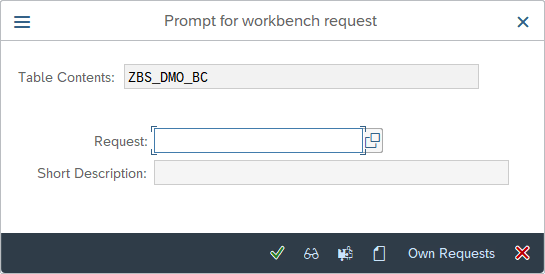
ABAP Cloud - Table maintenance
What actually comes after SM30 and how can you use Business Configuration today as a central maintenance tool for your tables? Read more in this article.
Table of contents
There will no longer be a GUI in ABAP Cloud, that is already given today. So how do you maintain tables and customizing in the system when classic maintenance is no longer available? In this article we will compare the two techniques and look at similarities and differences.
Introduction
For a very long time, transaction SM30 was the central entry point for maintaining tables, regardless of whether it was customizing or directly on the system as run data. With the switch to ABAP Cloud, this is no longer the standard, but there is already a replacement, the Business Configuration. This is a RAP object (ABAP RESTful Programming Model) that is visualized via a Fiori application. A variety of setting options are available to you.
Get started
To get an introduction to the topic, you can find some articles on the subject on our blog. Here we explain which applications and apps you need, which permissions are important and how you create the maintenance and configure it in the system.
BTP - Business Configuration (Creation)
BTP - Business Configuration (Usage)
BTP - Business Configuration (without Transport)
Comparison
In this section you will find a comparison of the features of today's table maintenance generator and the business configuration. We will look at the various important aspects that are required for this.
Creation
With classic maintenance, you create a table in the system (transaction SE11) and then generate the appropriate maintenance dialog using the table maintenance generator.
The generator then creates a function group with the corresponding function modules, dynpros and routines so that table maintenance is available. The objects are created in the customer namespace.
The business configuration is created as a RAP object. To do this, we need a table again and generate the stack using the RAP generator, similar to the function group.
When generating the objects, we have various setting options available to us in order to make adjustments and implement the corresponding naming conventions.
Adjustment
If you want to make adjustments to the maintenance dialog, you have two options in the generator: manually adjust the dynpros and regenerate various functions.
With the Business Configuration, we have no automatic adjustment options available. If a new field is added to the table, it must be added manually to the entire RAP stack. There is no simple regeneration of the objects, as in SE11.
Maintenance
To maintain the data, we must go to transaction SM30 or create our own transaction in order to be able to assign authorizations. In the transaction, we can search for the various maintainable tables and display the data or edit it directly.
The actual maintenance of the data takes place via a table control in the SAP GUI. Value help can be stored via the data elements. We have to develop further data validations ourselves via events in the function group.
You can start maintaining the business configuration via the Fiori app "Custom Business Configurations" (F4579), there we can choose from the various authorized objects.
The data can be maintained using various table formats, whether as a responsive table with the corresponding object page or as a grid table across the entire width of the data.
Transport
If it is a customizing table, the transport is also queried when the entries are saved. CTS (transaction SE10) is used here as the standard distribution.
The situation is similar with business configuration. Before we can save the entries, the system wants us to choose a transport. At least if we also want to distribute the entries.
If we then want to export the settings, the Fiori app "Export Customizing Transports" is available to us. (F5069) so that business users can also release the transports without needing the ABAP Development Tools (ADT).
Own app
The use of the Business Configuration is not mandatory if you maintain data in the system or want to enable others to do so. It is also possible to build your own RAP application and deploy it as a separate Fiori app in the system. In terms of artifacts, the two applications then hardly differ.
However, you should then be aware that you also have to take care of a Fiori application, for example for updates, and that you should back up the application in Git. In addition, standard functionalities such as transport recording or Excel upload for the business configuration are no longer available.
Availability
With the introduction of ABAP Cloud On-Premise, the business configuration is also available in an S/4 HANA 2022 system and can replace your SM30 maintenance dialogs. However, it may be that you do not need an IAM app and business catalog, but instead map the authorizations in the classic way using PFCG roles.
In the S/4 HANA 2022 release, there may also be some deviations from the examples shown. For example, the RAP generator is still structured differently and the OData endpoint must be activated via the SAP GUI.
Conclusion
It is already possible to maintain tables in an on-premise system in a simple way. With the Business Configuration as its successor, such views can be created quite easily and in a modern way.















